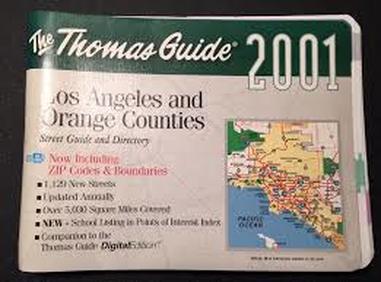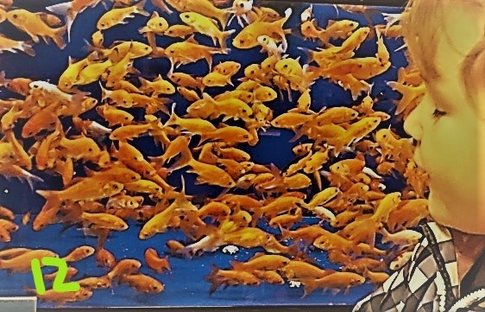 Thomas Guide - Navigation Tools From Long Ago... Thomas Guide - Navigation Tools From Long Ago... My kids ask about the olden days, "You know, like back in the 1900's." There are moment as we laugh that we realize there are reference points and resources which they will have no frame work to comprehend. One such resource that we used in the days long before was the Thomas Guide, do you remember these? We tale for granted that you now can instantaneous directions that are interactive and will talk you through the intricacies of your journey. In the days before cell phones and data applications were a ubiquitous accessory, you used to have to sit down at your computer to print your directions from programs such as Mapquest. People complain that Siri get's them lost, those same people should force themselves to navigate with line item directions while traversing through rush hour traffic. Prior to the Thomas Guide, there were maps. Maps were created as a by product of natural selection in an effort to thin the population either by getting them lost where they could not be found, distracted from driving or to tear families apart arguing over which minuscule turn off was the shortest route. Maps were sold in a compact folded form that you could never get them back into without tearing or throwing into the glove box in a condition twice the purchased size. Imagine driving with a fold out that could fill the drivers compartment trying to read size 6 font in the dark to reach your destination - it makes it rather comical that some crusaders believe cell phones are the first and/or only incarnation of distracted driving. Imagine family trips with no seat belts, no air conditioning and navigating from parchment paper. Needless to say, when the Thomas Guide came out, the world of travel for business and for pleasure became so much more compact and concise. The Thomas Guide had a reference index, you would look up your street and be provided an page as well as index from which you could begin to construct your routes. As crazy as it sounds, in metropolitan areas such as Los Angeles, California, with the Thomas Guide you could more readily re-navigate when there were traffic jams because you could focus in on the area you were headed to rather than having to mess with a the jumbled monstrosity of a large paper map. The world was still un-chartered waters but the Thomas Guide made you feel like you could master the seas, or at least not get so lost that you would be left to die in the expanse with your only friend being a volleyball. Where are we going with this? First, I wanted to share a story about the Thomas Guide with you young-ins who have never heard of such a thing. Secondly, navigation is an essential component of exploration as it relates to achieving your personal and professional goals. Technology has advanced and you may be able to master the latest and greatest electronic gadgets but that doesn't mean you understand how to navigate your journey, connect with the best resources or conquer your ambitions. Mentorship is a catch phrase in the current economy and yet connecting the pieces is harder than it sounds even though we have so many collaboration opportunities. As discussed previously, discussion among peers can be a powerful resource (HERE), like a planned summer vacation the search for ideas and tips can start with sharing with others where you want to visit, what you hope to see as well as asking if others have been where you are trying to go. If you have been frustrated in your search for mentorship - 1) you are not alone, 2) don't give up as it is a worthwhile pursuit and 3) don't discount the network that you have that can help keep you accountable to your vision (The Power of Discussion). Another great place to start is Write It Down. Let us know what you have learned about navigation and mentorship. Connect. Collaborate. Conquer.
0 Comments
 Image - CFS Health Image - CFS Health Without collaboration from the bottom up and organization will struggle to prevent the inevitable crumbling due to avoidable design failures. Business people from corporate executives to popular consultants on down to you average small business owner (down in the sense of scale not respect), often refer to business as a jigsaw puzzle. Life hands you an opportunity with a picture in mind but when it comes to reaching that vision it turns that if you want to succeed out there is a lot more work involved than just opening the box. Project management, which is a fancy term for the nuts and bolts on how stuff gets done, is more like a real world version of the classic block tower suspense game, Jenga. If you remember Jenga, it's a series of unilaterally sized blocks that are stacked together and each player has to take a piece out of the tower and reassemble at the top. Eventually the tower crumbles, it has to, but the goal is to not be the one who placed the final and fatal piece. The life lesson is so apt - don't be the fall guy or at least don't be the last one with your fingerprints on the block. Let's break this down a little further. First reality that Jenga teaches us about project management is that every organization has a great idea that starts with The Beautiful Plan. When Jenga, as a metaphor for an organization's next ground breaking business plan, is brought out of the closet where only the best ideas are stored everyone gathers around and celebrates. It's looks so beautiful and tidy in its snappy packaging with it's protective shield and the perfectly aligned pieces to the vertical puzzle. The plan is bullet proof they say. This can't lose they say. We've ran the numbers and it's going to be huge they say. To the optimist every plan is great and most visionaries are optimists. Once the packaging is set, the suits have bought into the vision and the protective shield has been placed around the fixture, it's up to the project managers and technicians to make the idea work. If the plan works the creators of the plan will take all the credit along with the rewards, if the plan fails then the blame will fall upon the last person to have touched the project. Oh, the beautiful plan. While the author is unknown, the sentiment is spot on with regards to the working definition of the key word teamwork, "Teamwork means you always have someone else to blame." The second reality of Jenga falls in line with the laws of thermodynamics, everything is subject to entropy. Entropy is basically chaos or the reality that all things, including systems, will eventually break down over time. Author Lex Sisney applies these laws of science to his approach to business in his book Organizational Physics noting that the counter to entropy that will enable success is integration. Integration is both the measure of energy going into a system or process as well as the measure of efficiency in applying that available energy to productive outlets. Sisney, who is the co-founder and CEO of the world's largest affiliate marketing company, notes that, "When we manage the dynamic between entropy and integration with awareness and the right balance – that’s when we meet our potential to be successful beyond expectation." Jenga reflects many organizational ideas that are beautiful in the box but are inherently designed to fail when the plan does not value the collaboration at all levels in the implementation of the plan. For Jenga the pieces are moved in such a fashion that the goal is not to be the last one with the fatal piece, winning the game or business conducted in this manner isn't success it's status quo. The third principle that Jenga teaches us about successful project management is that if either or both of the prior two principles are true then the result will always be the same. Too often a project goes into sequence and the originators of the vision cannot or will not receive constructive criticism so either the team members are silent to their qualified objections or they are silenced when they bring their concerns to the leadership table. When admiring the package the vision was delivered in and protecting the pride of those whose crafted the concepts is more important that achieving the goals, a project is destined for failure. Diversity in backgrounds, ideas, upbringing, professional experience and culture are all valuable to an organization because they broaden the perspective of the team. If an organization fosters value, input and collaboration from all levels then there is a fighting chance for that team to achieve their collective vision rather than continuing to build and maintain towers designed to crumble. Toyota has long been studied and copied for their commitment to quality in production and their ability to streamline their processes. Anyone who has studied Kaizen or lean management principles has heard about the andon cord that was a revolutionary staple in the Toyota facilities. This andon cord was a means of empowering every employee along the line of production to have real input in maintaining the quality of the Toyota vision. By pulling the red cord which was strewn throughout the workstations the individual employees could stop the assembly, a huge potential cost to the organization, for quality or other concerns. Through this system Toyota creates a clear culture around the concept of quality and generates accountability within the system that empowers the organization from the bottom up. Some people have said that Toyota is doing away with the andon cord, which actually isn't true, the red cord is being replaced with a yellow button that is wireless. Toyota isn't reverting to pre-Kaizen methodologies because it was too costly, they are updating the system to create better usage at the ground levels of their organization. If you are in business, your organization is like a Jenga tower, forces are always pulling at the blocks of your company and ready to see it crumble whether those forces are natural such as entropy or external in the form of competition the pressure is there. As noted above the counter measure to entropy is integration and one of the greatest benefits of team collaboration from the bottom up is ensuring that the pressure that crumbles your organization doesn't come from within. Most great civilizations have disappeared into history not because they were conquered by their enemies but by being torn apart internally. If leadership does not seek, does not listen and does not receive input from every level of their organization they will notice that team members become silent which will create a great void in the companies ability to sustain success. (Read more on our article How Open is That Open Door - HERE) As in parenting, managers should not be concerned when employees are bringing issues to them as this often communicates that those team members still care, rather a leader should be concerned when the team is silent. Nothing good rarely results when children or employees are silent. Connect. Collaborate. Conquer  Prepare. Prevent. Prevail. Protecting your non profit organization. Prepare. Prevent. Prevail. Protecting your non profit organization. Non profit organizations have as much to lose when business is interrupted as for profit businesses do and in many cases more to lose. Maintaining business continuity involves having the right knowledge base to understand risks and prepare your team to prevent those items that can be avoided as well as prevail in the event that something negative occurs that impacts the operational flow. A non profit can face losing membership, clientele and support, which can include grant dollars, funding sources, leased space, momentum and core team members in the event that business as usual is no longer feasible due to a disaster event such as water or fire damages. While no entity can be prepared for everything, even in a non profit or mission based organization it is important to spend some administrative time to think through the potential risk exposure for your organization (read more on risk assessment and creative solutions HERE). A non profit may not have profits at stake which would be a critical concern for a traditional business, because of the nature of the work at the organization there may be even more at risk in these types of operations. Business continuity includes mission momentum, funding, community progress and team cohesion. People and organizations often don't have spare time so disaster preparation becomes an item that can be put off, unfortunately until an event happens that forces the parties involved to retroactively wish that they have made it a priority. Prevention is another agenda item that seems too time intensive to be of value in expending limited resources. Often many disasters could have been prevented by simple exploration of basic functions, risk assessments and changes to process improvements. An organization should leverage their resources to assist them in protecting their operational continuity, as noted in a prior article and presentation for property owners (see HERE on insurance claims education), make your insurance agent work for their money in reviewing your policy and assisting with risk management. If you have resources in your leadership, executive boards and even your volunteer base, include time for input as well as assistance in protecting your organization. The time and resources spent on education, risk assessment and prevention may not show up on the balance sheet, but when you consider what your organization does on a day to day basis for the benefit of the community, business continuity for your operation means more than just saving dollars. Consider what is at stake if your mission were to lose momentum, especially due to something that may have been preventable, and budget in time to invest in preparation and prevention so that you can continue to prevail. If you would like to discuss further how we can assist, we would love to help boost the knowledge of your team so that we can collaborate in prevention - and should the worst occur, we are here to assist with response. We have had the great privilege of helping churches, non profit organizations, educational facilities and mission based entities protect and restore their businesses following water, fire and other related disasters. We see the commercials where the individuals on screen are reported to be "real people," and surprisingly enough all real people in commercials are very complimentary of the product that they are really learning about and all of their responses are totally real? Take a peek at this commercial from Zebra Corner that is embedded in our article. "What is initial quality? Initially it's ok and then it's a piece of crap? Is that what you're saying here?" The commercial spoof both puts so many common practices on blast - the concept of ambiguous rewards that sound good, the sheep staring at a new gate positive responses to the message and method of revelation in commercials with real people and the lack of reality in the whole presentation. What is a reward for "initial quality"? As questioned by our protagonist, "Did you rent this whole building just to show off all the cars that you didn't sell?" There is so much that is funny about this commercial but much of the humor comes from someone simply asking the questions that we all are or should be asking. If your business is convincing people that you are the best, there may be an issue with your service or product. Billionaire owner of the Dallas Mavericks and gritty entrepreneur Mark Cuban writes in his e-book How To Win, "Rather than trying to convince people you are the best, let the quality of your work do the talking." Your messages should come from your vision and be an extension of your values, the most effective marketing or branding messages flow from who you are as an organization because they are authentic and will be supported throughout a client's interaction with your business. Too much time is spent on relevance that companies fail to just be relevant (read more about this HERE). Connect. Collaborate. Conquer. |
AuthorThoughts on personal and professional development. Jon Isaacson, The Intentional Restorer, is a contractor, author, and host of The DYOJO Podcast. The goal of The DYOJO is to help growth-minded restoration professionals shorten their DANG learning curve for personal and professional development. You can watch The DYOJO Podcast on YouTube on Thursdays or listen on your favorite podcast platform.
Archives
March 2023
Categories
All
<script type="text/javascript" src="//downloads.mailchimp.com/js/signup-forms/popup/unique-methods/embed.js" data-dojo-config="usePlainJson: true, isDebug: false"></script><script type="text/javascript">window.dojoRequire(["mojo/signup-forms/Loader"], function(L) { L.start({"baseUrl":"mc.us5.list-manage.com","uuid":"b9016446bd3c6a9f0bd835d4e","lid":"83282ffb9e","uniqueMethods":true}) })</script>
|
Jon Isaacson |
Connect. Collaborate. Conquer.
© COPYRIGHT 2015. ALL RIGHTS RESERVED.
|



 RSS Feed
RSS Feed